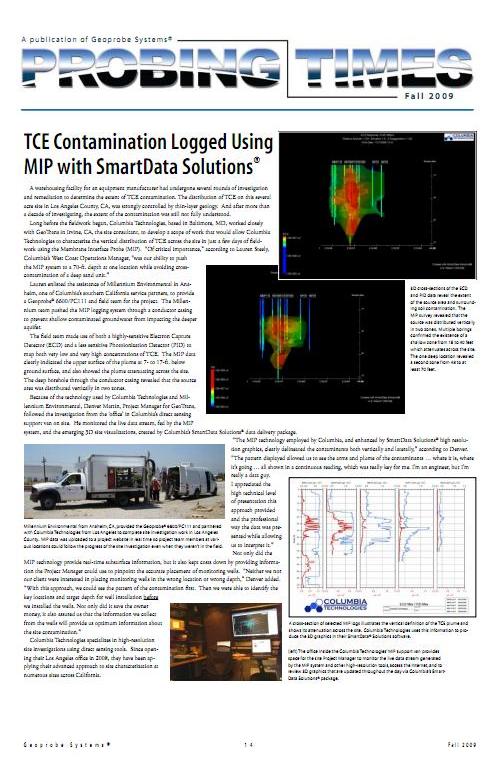Article originally featured in the Probing Times, the official newsletter of Geoprobe Systems® Fall 2009 Issue
Long before the fieldwork began, Columbia Technologies, based in Baltimore, MD, worked closely with GeoTrans in Irvine, CA, the site consultant, to develop a scope of work that would allow Columbia Technologies to characterize the vertical distribution of TCE across the site in just a few days of fieldwork using the Membrane Interface Probe (MIP).
"Of critical importance," according to Lauren Steely, Columbia's West Coast Operations Manager, "was our ability to push the MIP system to a 70-ft. depth at one location while avoiding cross-contamination of a deep sand unit."
Lauren enlisted the assistance of Millennium Environmental in Anaheim, one of Columbia's southern California service partners, to provide a Geoprobe® 6600/PC111 and field team for the project. The Millennium team pushed the MIP logging system through a conductor casing to prevent shallow contaminated groundwater from impacting the deeper aquifer.
The field team made use of both a highly-sensitive Electron Capture Detector (ECD) and a less sensitive Photoionization Detector (PID) to map both very low and very high concentrations of TCE. The MIP data clearly indicated the upper surface of the plume at 7- to 17-ft. below ground surface, and also showed the plume attenuating across the site. The deep borehole through the conductor casing revealed that the source area was distributed vertically in two zones.
Because of the technology used by Columbia Technologies and Millennium Environmental, Denver Martin, Project Manager for GeoTrans, followed the investigation from the 'office' in Columbia's direct sensing support van on site. He mentioned the live data stream, fed by the MIP system, and the emerging 3D site visualizations, created by Columbia's SmartData Solutions® data delivery package.
"The MIP technology employed by Columbia, and enhance by SmartData Solutions® high resolution graphics, clearly delineated the contaminants both vertically and laterally," according to Denver.
"The pattern displayed allowed us to see the arms and plume of the contaminants ... where it is, where it's going ... all shown in a continuous reading, which was really key for me. I'm an engineer, but I'm really a data guy. I appreciated the high technical level of presentation this approach provided and the professional way the data was presented while allowing us to interpret it."
Not only did the MIP technology provide real-time subsurface information, but it also kept costs down by providing information the Project Manager could use to pinpoint the accurate placement of monitoring wells. "Neither we nor our client were interested in placing monitoring wells in the wrong location or wrong depth," Denver added. "With this approach, we could see the pattern of the contamination first. Then we were able to identify the key locations and target depth for well installation before we installed the wells. Not only did it save the owner money, it also assured us that the information we collect from the wells will provide us optimum information about the site contamination."
Columbia Technologies specializes in high-resolution site investigations using direct sensing tools. Since opening their Los Angeles office in 2008, they have applied their advanced approach to site characterization at numerous sites across California.
Read the full article by viewing the Fall 2009 issue of the Probing Times, the official newsletter of Geoprobe Systems®.



